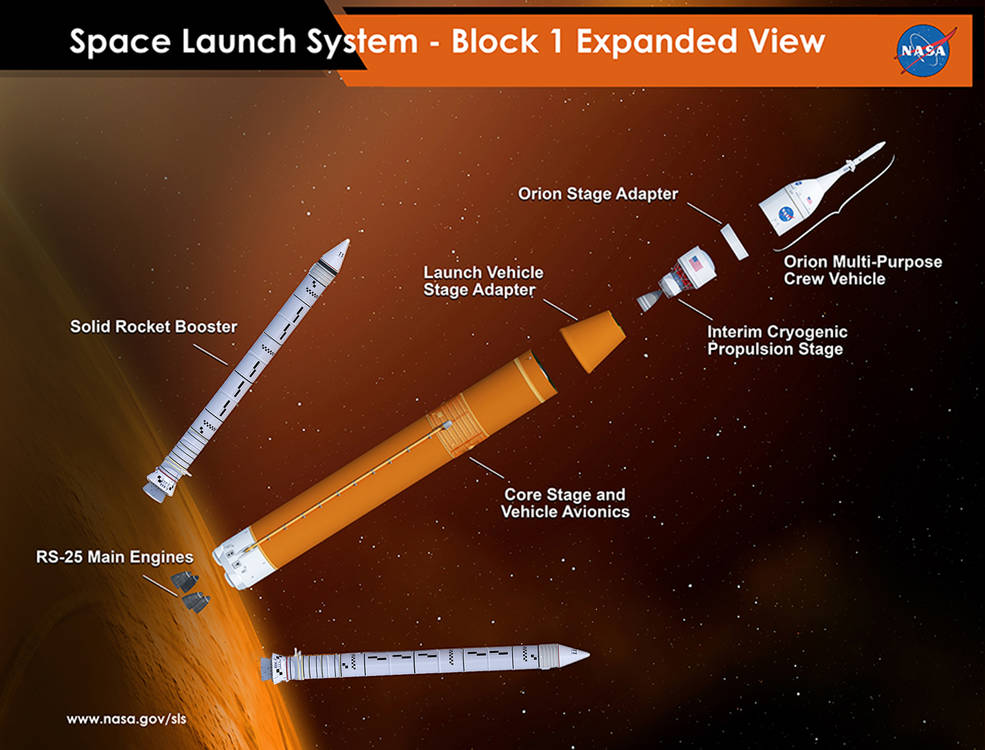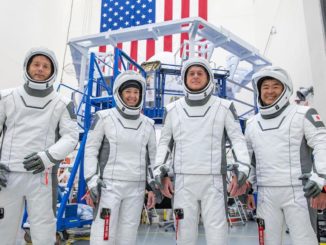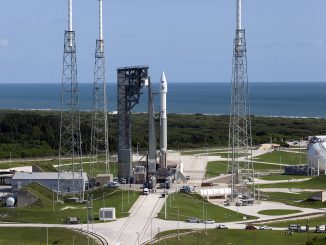
One of the final pieces for the first test flight of NASA’s huge Space Launch System heavy-lift rocket recently arrived at the Kennedy Space Center, joining other elements already at the Florida spaceport awaiting shipment of the SLS core stage once it completes testing at a NASA facility in Mississippi.
The Launch Vehicle Stage Adapter, or LVSA for the first SLS test launch arrived at the Kennedy Space Center in Florida aboard NASA’s Pegasus barge July 29. Early the next day, hours before the liftoff of NASA’s Mars 2020 Perseverance rover from a launch pad a few miles away, ground crews transferred the LVSA from the Pegasus barge into the Vehicle Assembly Building at the Florida spaceport.
The LVSA is the second-to-last element of the first Space Launch System rocket to arrive at the Kennedy Space Center. The biggest piece of the rocket, known as the core stage, is expected to arrive at Kennedy after test-firing of its four main engines on a test stand in Mississippi later this year.
Assuming that test-firing milestone is completed this fall, and assembly of the huge rocket goes as planned next year inside the VAB, the first SLS test flight could blast off before the end of 2021.
That’s about four years later than predicted when NASA initiated the design and development of the SLS in 2011, delays largely attributed to difficulties in building and testing the core stage.
The first SLS test flight, known as Artemis 1, will send an unpiloted Orion crew capsule on a mission to orbit the moon. NASA will check out the rocket’s performance and the Orion spacecraft’s systems before the first SLS/Orion mission with astronauts in the 2023 timeframe.
Under NASA’s current plans, the third SLS/Orion mission will carry astronauts to the moon to attempt the first crewed lunar landing since the end of the Apollo moon program in 1972. The Trump administration has directed NASA to try to land astronauts on the moon before the end of 2024, a schedule widely viewed as highly ambitious that also hinges on billions of dollars in fresh funding from Congress.
The Launch Vehicle Stage Adapter that arrived at Kennedy in late July will connect the SLS core stage with the rocket’s Interim Cryogenic Propulsion Stage, or upper stage. The structural adapter element was built at NASA’s Marshall Space Flight Center in Huntsville, Alabama, under the management of prime contractor Teledyne Brown Engineering.
“The Launch Vehicle Stage Adapter arriving to Kennedy is significant because we have almost all of the pieces of the rocket here as we get closer to launch,” said Allison Mjoen, operations project engineer with NASA’s Exploration Ground Systems program. “We have moved from planning into implementation, and soon the rocket will begin taking shape with stacking operations.”
NASA’s Pegasus barge transported the LVSA by river and sea from Huntsville to the Kennedy Space Center. The same vessel carried external tanks to the launch site during NASA’s space shuttle program, and will also transport the Artemis 1 core stage from Mississippi to Florida after the test-firing.
The cone-shaped adapter measures about 30 feet, or 9 meters, tall and will be stored inside the VAB until needed for stacking on top of the core stage some time next year. The LVSA will also help protect the upper stage’s RL10 engine during the early minutes of the SLS launch, before the RL10 fires to send the Orion capsule on a trajectory toward the moon.
The entire Space Launch System rocket will stand 322 feet (98 meters) tall.

Other elements for the first SLS test flight currently at the Florida launch site include all segments of the rocket’s twin solid rocket boosters, which arrived by train in June from their Northrop Grumman factory in Utah. The ICPS upper stage, built by United Launch Alliance, is undergoing inspections and maintenance at ULA’s Delta Operations Center at Cape Canaveral Air Force Station to prepare for stacking on top of the core stage and the Launch Vehicle Stage Adapter.
The Orion Stage Adapter, which connects the SLS upper stage with the Orion crew capsule, is also at the Kennedy Space Center.
And the Orion spacecraft itself finished its pre-flight test campaign earlier this year. The spacecraft’s Lockheed Martin-built crew module and Airbus-made service module, along with the ship’s launch abort system, are all at Kennedy awaiting the arrival of the SLS core stage and the start of final launch preparations.
Email the author.
Follow Stephen Clark on Twitter: @StephenClark1.



